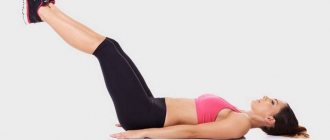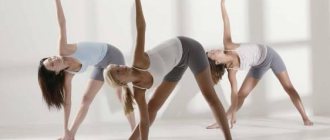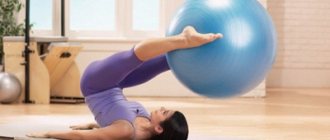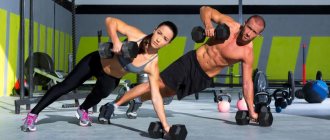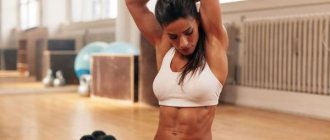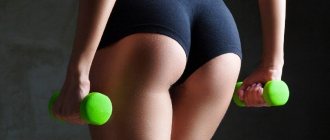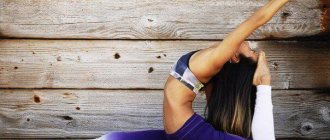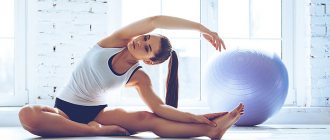If you want to minimize the harm from a sedentary lifestyle, get rid of back pain and feel free and relaxed, then stretch your entire body at least once a week.
We offer you a universal set of exercises for stretching all muscle groups, which is suitable for both beginners and experienced practitioners.
Warm up before stretching
When you stretch after a workout, your muscles are already warmed up and no additional warm-up is required. If you decide to arrange a separate stretching lesson, first do a few exercises:
- Joint warm-up: twirl your joints, bend and twist your body.
- 5-7 minutes of cardio: running or Jumping Jacks, Rock Climber, running in place with high knees, jumping rope.
Once you've warmed up a bit, you can start stretching.
Why develop body flexibility in strength sports?
Over time, training in strength sports such as weightlifting, powerlifting, bodybuilding, crossfit, muscle fibers are noticeably shortened. This is due to the fact that basically all exercises are aimed at maximum peak contraction, at which either an increase in strength or an increase in muscle mass is achieved. Constant contraction shortens the muscles, putting them into spasm, which persists and only intensifies.
Since the emphasis in strength training is on the positive, contractile phase, the negative or relaxation phase is performed with minimal amplitude, which is not capable of returning the muscles to their normal physiological state. And this subsequently contributes to the deterioration of blood supply to the muscles, slower recovery, and increased injury to muscles, joints and ligaments. All this leads to a slowdown in the growth of mass and strength, to overtraining, due to which progress stops and a number of negative factors appear on the part of the functions of the musculoskeletal system.
Therefore, it is important to return the muscles to their normal state, and this is achieved by stretching the muscles and ligaments after exercise. In the future, you can achieve faster results in strength sports than in the absence of flexibility development.
How and how much to stretch
With these exercises, you can arrange an independent stretching session and thoroughly stretch all the muscles of your body. However, it will take about 60–90 minutes. For a quick stretch, choose one or two exercises for each muscle group involved in the workout.
To give your muscles a good stretch, hold each pose for 30 seconds to two minutes. You can remain still or gently spring. Sudden movements can cause injury, so leave them for another sport.
We will give exercises for stretching from top to bottom: neck, shoulders and arms, chest and back, abs, buttocks, thighs, legs.
Types of Flexibility
The form of influence is:
- Active flexibility is an indicator of performing an exercise with an amplitude achieved by one’s own muscular efforts. For example, swinging in a half-split is performed using your own muscles.
- Passive flexibility is an indicator in which the amplitude of movement is achieved with outside help, without muscle effort. For example, stretching with a rubber band, weight, or pressure from a partner.
According to the method of influence it happens:
- Dynamic flexibility - achieved by performing a movement. For example, high leg swings.
- Static flexibility - achieved by holding a pose in a static, motionless state. For example, splits without swinging.
Neck stretching exercises
Tilt of the head back and to the side
Tilt your head back, stretching the front of your neck. From this position, tilt your head to the left. For greater effect, place your left palm on the right side of your head, but do not press hard.
Repeat the exercise on the other side.
Head tilt forward and sideways
Place your right hand on the left side of your head. Tilt your head forward and to the side, increase the pressure with your hand.
Repeat on the other side.
Back of the neck stretch
Place one hand on the back of your head and the other on your chin. Lower your head, making a double chin. At the same time, the neck remains straight, the back of the head tends upward. You should feel tension in the back of your neck, especially at the base of your skull.
The difference between stretching and other fitness systems
Stretching as a training system has certain differences, the main ones:
- Smoothness of the movements performed - if all rules of exercise are observed, injury is excluded;
- For training, you only need a sports mat, no additional exercise equipment is needed;
- There are no restrictions on the level of physical fitness and age;
- During exercise, not only the muscles are exposed, but the entire body as a whole, including the ligamentous-articular apparatus.
Stretching is becoming one of the most favorite types of fitness for many people. The exercises can be performed in the gym and at home, which allows you to find free time for exercise on any day.
Shoulder stretches
Front Shoulder Stretch
Place your hands behind your back, clasp your wrist with one hand and the other. Bend your elbows and lift your wrists higher. Push your chest forward and feel the stretch in the front of your shoulders.
Mid Shoulder Stretch
Grab your opposite elbow with your hand, press your shoulder towards you and pull it down. Repeat with the other hand.
Back Shoulder Stretch
Grasp your right arm with your left above the elbow, press it to your body and straighten it, lower your right shoulder down. With your left hand, pull your right hand up, lifting it with your elbow. Feel the tension in the back of your shoulders.
Repeat with the other hand.
Triceps stretch
Go to the wall, lift your left elbow up, and place your forearm behind your back. Lower your left shoulder blade down. To check that it has actually dropped and will not rise during the stretch, place your right hand below your left armpit.
Repeat on the other side.
Biceps stretch
Grab a doorknob, counter, or other support and turn your back to it. Turn your elbow upward and move your body slightly forward.
Repeat with the other hand.
Triceps and Shoulder Stretch
This pose allows you to simultaneously stretch the triceps of one arm and the front of the shoulder of the other. Place one hand behind your back from above so that your elbow points upward, and the other from below so that your elbow points to the floor. Try to bring your wrists together behind your back at the level of your shoulder blades.
Switch hands.
Wrist Extensor Stretch
Sit on your knees, place your hands in front of you so that the backs of your hands touch the floor and your fingers point towards each other. Gently shift your weight into your hands, stretching your forearms. To enhance the effect, try clenching your fists.
Recommendations for developing flexibility
- To begin with, this complex will be enough to stretch the main muscles of the body and work out the joints. These flexibility exercises can be performed as a stand-alone routine after a good warm-up, or at the end of a strength training session as a cool-down.
- This type of training is enough three times a week.
- Remember about the traumatic nature of fibers and ligaments, do not cause acute pain. Do not perform the movements abruptly, this can stretch the fibers and the recovery will be painful.
- Never perform flexibility exercises with cold muscles. Place a mat to keep your muscles warm from the cold floor. The higher the body and room temperature, the more pliable and elastic the muscles will be.
Chest stretching exercises
Chest stretch in the doorway
Approach the doorway, lean your elbows on the doorframes and push your chest forward, stretching your pectoral muscles.
Wall Chest Stretch
Place your hand on the wall, lower your shoulder and turn in the opposite direction. Repeat with the other hand.
Contraindications
Stretching is contraindicated:
- During the recovery period after injuries and severe diseases of the spine;
- For fractures;
- During the period of exacerbation of inflammatory and degenerative diseases of muscles, tendons and ligaments;
- People with severe varicose veins;
- People with decompensated stages of pathologies of the cardiovascular system.
Stretching can also be used as physical therapy, but in this case, sets of exercises should be selected only by a doctor and carried out under the guidance of an experienced specialist.
Back stretching exercises
Back stretch at the counter
Stand next to a rack, exercise machine or other support, turn your left shoulder towards it. With your right hand, grab the rack high above your head and move your pelvis to the right and down, stretching the entire right side of your body.
Repeat on the other side.
Stretching the lower back muscles
Sit on the floor, move your right leg forward, left leg back. Bend your knees at an angle of 90 degrees or slightly more. Place your right hand on the floor, raise your left above your head. Pull your left leg down and back, tilt your body forward and twist towards your right leg.
Switch legs.
Back extensor stretch
Sit on the floor, bend your knees and place your feet on the floor. Grasp your shins with your hands on the inside, place your wrists on your feet. Bend forward with a round back as low as possible.
Child's pose
Sit on the floor, buttocks should touch your heels. Lean forward, lie on your stomach on your knees and extend your arms.
Downward Facing Dog Pose
Get on all fours, then move your pelvis back and up so that your body resembles an angle. Your arms and back should be stretched out in one line, your knees can be bent, and your heels can be lifted off the floor. The main thing is that your back remains straight, without rounding in the lower back.
Hanging traction
Grab a low horizontal bar and hang freely, relaxing your body. Feet should remain on the ground. Relax them, bend your knees slightly.
Inverted back stretch
Lie on the floor on your back, arms along your body, legs straight. Raise your legs and then throw them behind your head. Hands rest with elbows on the floor, hands support the lower back. Do not lean on your neck, the fulcrum is your shoulders.
Abdominal stretching exercises
Camel Pose
Get on your knees, push your chest up, lengthening your spine, and then lean back, placing your hands on your heels. Try to bend in the thoracic region. Don't throw your head back, look up.
Upward-facing dog pose
Lie on the floor on your stomach, place your hands under your shoulders. Push yourself up, your pelvis rises, your legs remain on the floor. Lower your shoulders, bend in the chest.
Standing Backbend
Stand straight with your feet together. Raise your arms and join your palms above your head. Bend your chest and tilt your body back. Tighten your buttocks to prevent a strong arch in your lower back.
Side tilt
Stand up straight, raise your arms above your head, clasp your fingers and turn your palms up. Stretch up and bend first to one side and then to the other.
Lying spinal twist
Lie on the floor on your back, arms out to the sides, palms down. Move your pelvis to the left, lift your left leg, bending it at the knee, move it behind your right leg and try to place your knee on the floor. Turn your head to the left and relax.
Repeat the exercise on the other side.
Exercises for stretching the buttocks
Lying stretch
Lie on the floor on your back, raise your knees bent. Place the ankle of your left foot on the knee of your right. Press the knee of your right leg onto your left to deepen the stretch. Repeat with the other leg.
Stretch on all fours
Get on all fours, place your right ankle on your left knee. Push your pelvis back to deepen the stretch. Repeat with the other leg.
Stretching while sitting
Sit on the floor, stretch your legs forward, straighten your back. Bend one leg at the knee, grab your shin with your hands and press it to your chest. The shin should be parallel to the floor, the forearms lie on top and press it to the chest, one hand covers the other.
Repeat with the other leg.
Pigeon pose
Sit on the floor, bend one leg at the knee at a right angle and move it forward, take the other back and straighten it. You can lean forward and place your forearms on the floor.
If you have difficulty doing this pose on the floor, try placing your foot on an elevated platform.
Exercises to stretch the front of the thigh
Lying quadriceps stretch
Lie on the floor on your stomach, lift one leg and place your hand on your ankle. Pull your leg towards your buttock, trying not to lift your thigh off the floor. Repeat with the other leg.
Single Knee Quadriceps Stretch
Get down on one knee, grab the toe of your back leg with your hand and pull your heel towards your buttock. Squeeze your gluteal muscles: this will deepen the stretch. Repeat with the other leg.
Hip flexor stretch
Get on one knee with both legs bent at a 90-degree angle. The back is straight. Tighten your gluteal muscles and move your pelvis slightly forward. You should feel tension in the front of your back leg and in your groin.
Switch legs.
Deep Lunge
Take a deep lunge forward. Place your fingers on the floor on either side of your foot. Lower the knee of the straightened leg to the floor. Try to go lower and do not turn your pelvis to the side.
Switch legs.
Cloth
You should exercise both at home and in the gym in specially selected clothes. It should be made of durable and at the same time elastic materials. The trainee should not feel that the clothes are tight, pressing, or making it difficult to move.
It is best to purchase a suitable suit at specialized sales points, where sales consultants can select shorts, leggings, tops, T-shirts, based on the type of expected load, size, and comfort.
Exercises to stretch the back of the thigh
Hamstring stretch with expander
Lie on the floor, leave one straight leg on the floor, raise the other. Place an expander, jump rope or rope over your foot and pull your leg towards you. Switch legs.
Stretching while standing
Stand up straight, take a step forward. Tilt your body almost parallel to the floor. If you leave the leg straight, the upper part of the back of the thigh is stretched more; if you slightly bend the leg at the knee, the lower part is stretched.
Repeat with the other leg.
Tilt to feet
Sit on the floor, stretch your legs straight forward. Bend towards your feet and place your hands on either side of your feet or slightly further away. To deepen the stretch, you can straighten your back for a few seconds and then bend down again.
Bend to one leg
Sit on the floor, stretch one leg forward, bend the other at the knee and place your foot next to your pelvis. Bend towards your straight leg, grab your foot with your hands and pull the toe towards you. Try not to round your back.
Repeat with the other leg.
Bend while standing
Spread your legs wider, toes pointing forward. Lower your body down, keeping your back straight, until you place your palms on the floor.
Longitudinal twine
Split into a side split so that your iliac crests point forward. Place your palms on the floor and support your body weight on your hands. Try not to turn your hips and shoulders to the side.
Inner Thigh Stretching Exercises
Deep squat
Stand next to a rack or machine that you can hold on to. Feet shoulder-width apart, toes and knees turned outward. Lower yourself into a deep squat, keeping your back straight.
Butterfly near the wall
Sit on the floor with your back straight, fold your legs in front of you with your feet facing each other. Try to lower your knees to the floor, but do not put pressure on them with your hands. Keep your back straight.
Frog
Lie on the floor on your stomach, spread your knees to the sides and bend your legs at a right angle. Try to place your pelvis on the floor.
Frog with straight leg
Lie on the floor on your stomach, spread your knees out to the sides so that your thighs are parallel to the floor. Bend one leg at the knee, straighten the other. Try to place your pelvis on the floor. Repeat with the other leg.
Forward fold
Sit on the floor, spread your straight legs wider, and then lean forward. Try to lie on your stomach on the floor, do not bend your knees.
Cross twine
vova130555/ru.depositphotos.com
Split into a cross split. Do not move your pelvis too far back; ideally it should be in line with your knees and feet. Place your palms on the floor, and if stretching allows, your forearms. Pull your pelvis down towards the floor.
Stretching next to the wall
Lie on the floor close to the wall. The body should be perpendicular to it. Spread your legs and let them slowly lower under your weight. Stay in this position for 5–10 minutes.
Exercises to stretch the outer thigh
Hip abduction
Stand next to a wall, turning your right side towards it. Place your right leg behind your left and squat down. The left leg bends, the right leg remains straight and moves further to the left. The straight body hangs over the left leg.
Repeat on the other side.
Stretching while standing
Place your left leg behind your right in front and lean to the left. You can place one hand on your belt, fold your arms above your head or in front of you. The more the body tilts, the better the muscles stretch.
Basic principles of stretching
The main principle of stretching is overstretching. During training, muscles throughout the body are stretched, flexibility and plasticity of large joints increase.
These exercises help:
- Improve muscle tone and plasticity;
- Normalize weight;
- Gets rid of cellulite deposits;
- Do the splits;
- Make joints mobile;
- Slow down the aging process of the body.
After training, a surge of strength appears, you feel extraordinary vigor, tension is relieved, and all these effects persist almost throughout the day.
To maximize flexibility, daily intensive sets of stretch exercises are necessary; they allow, due to the cumulative effect, to maintain the achieved level of muscle stretching.
In the future, to maintain the developed stretching, it is enough to devote one to two days a week to stretching.
Calf Stretching Exercises
Stretch against the wall
Press the toe of your right foot against the wall, take your left foot a step and a half back. The feet are pressed tightly to the floor, the left leg is straight. Try to reach the wall with your right knee, this will stretch the muscles of your left leg.
Switch legs.
Heel Wall Stretch
Stand close to the wall. Place your right toe on the wall, take your left leg a step and a half back. Bend your left leg at the knee, increasing the stretch. Switch legs and repeat.
Anterior calf stretch
Sit on the floor, stretch your legs straight in front of you. Place the foot of one leg on the thigh of the other. Grab your foot with your opposite hand and pull your toe up.
Switch legs.
